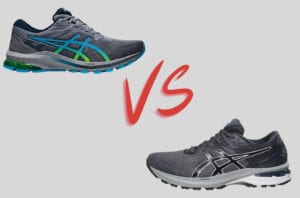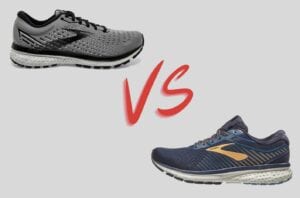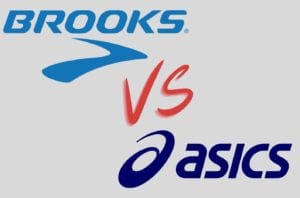Brooks running shoes are one of the most popular brands out there, and with good reason. Brooks is known for creating beautifully designed, high-performance daily trainers to improve your run and ideally prevent injury.
Brooks combines their knowledge of running with feedback from their consumer to improve all lines of their shoes. As a result, they’ve recently released the newest models of two of their most popular shoe lines, Ghost and Glycerin.
Brooks
Ghost and
Glycerin running shoe lines are neutral running shoes that Brooks has perfected for almost every runner.
The Ghost 13 and Glycerin 19 come with all your favorite features of the models before, as well as much-needed improvements. Take a look at the key similarities and differences between the two newest models of the Brooks Ghost vs Glycerin.
Brooks Ghost and Glycerin Compared
Upper
The Brooks Ghost 13 and Brooks Glycerin 19 are both padded and comfortable running shoes. The Brooks Ghost 13 has a new look; unlike previous models of the Ghost line, this one comes with an Air Mesh material. The air mesh gives runners more breathability to help keep them cool and reduce hot spots during their run or workout.
Like Brooks Ghost 13, the Brooks Glycerin 19 comes updated with a different style of mesh upper. However, even though it’s a different breathable mesh than the Brooks Ghost 13, you’ll still have a breathable shoe to get you through your run.
The mesh used on both the Brooks Ghost and Brooks Glycerin is incredibly flexible and gives your foot more room to move naturally. This allows for more natural and flexible foot stride movement and can help prevent injury from running.
A significant difference between the Brooks Ghost 13 and Brooks Glycerin 19 is the width sizes to choose from. The Brooks Glycerin 19 comes in normal and wide for men and normal, wide, and narrow for women.
The Brooks Ghost 13 offers more variety for a wide foot than the Brooks Glycerin 19. Men can choose from normal, narrow, wide, or extra wide, and women can choose from normal, wide, and narrow.
Aside from being stretchy, breathable, and roomy toe box, the Brooks Glycerin has a gusseted tongue constructed from stretchy nylon polyester that contributes to its plush feeling and a cushioned ride.
Sole
The material that the soles of your everyday trainer shoes have can make a huge difference in your running performance. Brooks’ designers created some shoes that perform better for short-distance runs, whereas others are more beneficial for longer runs.
With the launch of the latest Brooks Ghost model comes a new and improved sole. The Brooks Ghost 13 has a full-length DNA LOFT midsole technology and a segmented crash pad that makes the soles more comfortable than the models before this one. Adding the DNA midsole gives runners a smooth, more comfortable ride.
The Brooks Glycerin GTS 19 also has some improvements to the sole. The outsole of this shoe has rubber that gives those who land on their heels more durability. The durable rubber outsole is thinner than previous versions, but it still protects runners’ feet.
Both of these shoes have flex grooves. Flex grooves give the running shoes more flexibility so that runners can move more naturally. The difference between the two when it comes to the flex grooves is the placement. In comparing the Brooks Glycerin vs. Brooks Ghost, the Ghost 13’s flex grooves are from heel to toe, whereas on the Brooks Glycerin 19, they stop halfway to the forefoot. Also, the Brooks Ghost 13 has a firmer midsole compared to the Brooks Glycerin which is a little more cushioned.
Cushioning
One of the first things to look for in a good running shoe is cushioning. Having shoes that have plush uppers and responsive cushioning can help preserve your feet, legs, and joints.
Brooks Ghost and Glycerin lines have superior cushioning and energy return for running shoes. The Ghost Line is an excellent option for those who have plantar fasciitis. On the other hand, if you’re a runner who struggles with ankle pain or
numbness while running , purchasing even a moderately cushioned shoe may not be the best option for your daily training routine.
The level of cushioning in the Ghost 13 and Glycerin 19 has been consistent with previous models such as the
Ghost 12 and previous Glycerin models.
SEE ALSO: Brooks Ghost 12 vs 13
Heel to Toe Drop
If you’re new to running or a seasoned marathon runner and are trying to decide on a runner shoe for you, heel-to-toe drop is something you’ll want to consider. The heel-to-toe drop is the difference between the height of the heel and the height of the forefoot.
The Brooks Ghost 13 has a heel-to-toe drop of 12 mm, whereas the Glycerin 19’s is 9 mm. As a result, both Brooks shoes are considered average in this category, and many runners won’t be able to tell the difference between the two daily trainers.
Weight
One thing that many people don’t consider when looking at running shoes is their weight. If you don’t struggle with hip or knee pain, the shoe’s weight may not be as important to you. However, for those who have those issues, how much the shoes weigh can impact your performance.
Based on industry standards, the Brooks Ghost and Glycerin are considered lightweight.
As a result, the weight difference between the two lines is minimal.
The Ghost 13 shoes are lighter in weight. The Ghost 13 men’s shoes weigh about 10.1 ounces, and the women’s weigh 8.8 ounces.
The Glycerin 19 shoes have a heavier weight, but not by much. The Glycerin 19’s men’s shoes weigh 10.2 oz. and the women’s 9 oz.
While the weight difference is minimal, the Glycerin 19 comes with 20% extra cushioning, which adds to the minimal weight difference.
Something to keep in mind is that the larger the shoe size, the heavier the shoe. The difference shouldn’t be incredibly noticeable between sizes.
Price
The price tag on a decent pair of running shoes may come as a shock to some. Brooks products are more costly than an exercise shoe you can purchase at a local store, but the technology they implement can make a stark difference in your runs.
The Ghost 13 will cost you $130 regardless if you’re purchasing men or women pairs. The Brooks Glycerin 19 is slightly more expensive at $150. So, for those looking for a more inexpensive shoe, the Ghost is the way to go.
But, if the prices don’t matter to you, you’ll want to focus on other features that these neutral shoes have that matter to you.
Which Brooks Shoe Should I Buy?
These two shoes are incredibly similar, and deciding which line is better for you may depend on several factors.
Going with the Brooks Ghost 13 is probably a better choice for neutral runners that have narrower feet. Of Ghost 13 and Brooks Glycerin 19, Ghost 13 is the only one that offers a narrow width for men and two narrow widths for women.
[RELATED: Our Complete Brooks Ghost 13 Review]
If you’re a runner who prefers a shorter heel-to-toe drop, the Brooks Glycerin 19 will be a better fit for you.
For runners to run long distances or even daily, the Ghost 13 is probably the better choice. It’s lighter weight and stays comfortable on those long runs.
The Brooks Glycerin 19 only weighs slightly more than the Ghost 13, but some may find it harder to take them on longer runs. On the bright side, these stability shoes are great for shorter runs or for your daily after-work run.
[RELATED: Our Complete Brooks Glycerin 19 Review]
Final Thoughts
At the end of the day, you can’t go wrong with any running shoes from Brooks. This popular running shoe brand never ceases to impress. The Brooks Ghost and Brooks Glycerin are incredibly impressive running shoes that are sure to improve your strides and keep you running for longer.
Overall, the future is bright for Brooks running shoes as Brooks chases their goal of being carbon neutral by 2040 to reduce environmental impact of their new releases.






















